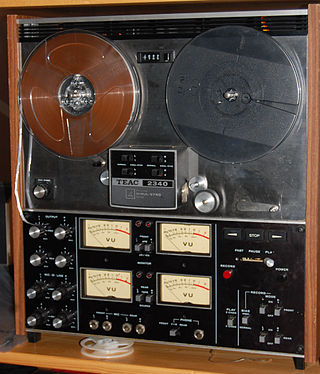
VHS is a standard for consumer-level analog video recording on tape cassettes, introduced in 1976 by the Victor Company of Japan (JVC). It was the dominant home video format throughout the tape media period throughout the 1980s and 1990s.

The Compact Cassette, also commonly called a cassette tape, audio cassette, or simply tape or cassette, is an analog magnetic tape recording format for audio recording and playback. Invented by Lou Ottens and his team at the Dutch company Philips, the Compact Cassette was released in August 1963.

An audio tape recorder, also known as a tape deck, tape player or tape machine or simply a tape recorder, is a sound recording and reproduction device that records and plays back sounds usually using magnetic tape for storage. In its present-day form, it records a fluctuating signal by moving the tape across a tape head that polarizes the magnetic domains in the tape in proportion to the audio signal. Tape-recording devices include the reel-to-reel tape deck and the cassette deck, which uses a cassette for storage.

The 8-track tape is a magnetic-tape sound recording technology that was popular from the mid-1960s until the early 1980s, when the compact cassette, which pre-dated the 8-track system, surpassed it in popularity for pre-recorded music.

Quadraphonic sound – equivalent to what is now called 4.0 surround sound – uses four audio channels in which speakers are positioned at the four corners of a listening space. The system allows for the reproduction of sound signals that are independent of one another.

Nagra is a brand of portable audio recorders produced from 1951 in Switzerland. Beginning in 1997 a range of high-end equipment aimed at the audiophile community was introduced, and Nagra expanded the company's product lines into new markets.

Reel-to-reel audio tape recording, also called open-reel recording, is magnetic tape audio recording in which the recording tape is spooled between reels. To prepare for use, the supply reel containing the tape is placed on a spindle or hub. The end of the tape is manually pulled from the reel, threaded through mechanical guides and over a tape head assembly, and attached by friction to the hub of the second, initially empty takeup reel. Reel-to-reel systems use tape that is 1⁄4, 1⁄2, 1, or 2 inches wide, which normally moves at 3+3⁄4, 7+1⁄2, 15 or 30 inches per second. Domestic consumer machines almost always used 1⁄4 inch (6.35 mm) or narrower tape and many offered slower speeds such as 1+7⁄8 inches per second (4.762 cm/s). All standard tape speeds are derived as a binary submultiple of 30 inches per second.
TEAC Corporation is a Japanese electronics manufacturer. TEAC was created by the merger of the Tokyo Television Acoustic Company, founded in 1953, and the Tokyo Electro-Acoustic Company, founded in 1956.

The Muntz Stereo-Pak, commonly known as the 4-track cartridge, is a magnetic tape sound recording cartridge technology.
Since the widespread adoption of reel-to-reel audio tape recording in the 1950s, audio tapes and tape cassettes have been available in many formats. This article describes the length, tape thickness and playing times of some of the most common ones.

The Fidelipac, commonly known as a "NAB cartridge" or simply "cart", is a magnetic tape sound recording format, used for radio broadcasting for playback of material over the air such as radio commercials, jingles, station identifications, and music, and for indoor background music. Fidelipac is the official name of this industry standard audio tape cartridge. It was developed in 1954 by inventor George Eash, and commercially introduced in 1959 by Collins Radio Co. at the 1959 NAB Convention. The cartridge was often used at radio stations until the late 1990s, when such formats as MiniDisc and computerized broadcast automation predominated.
Foster Denki KK is an electronics company that manufactures loudspeakers and audio equipment for other companies or sells them under the trade name Fostex. It is traded on the Tokyo Stock Exchange.

Multitrack recording of sound is the process in which sound and other electro-acoustic signals are captured on a recording medium such as magnetic tape, which is divided into two or more audio tracks that run parallel with each other. Because they are carried on the same medium, the tracks stay in perfect synchronization, while allowing multiple sound sources to be recorded at different times.

British Tape Recorders or BTR machines were reel-to-reel audio tape recorders initially made by EMI in England after World War II. They were the first magnetic tape recorders to be manufactured in Britain, and their design imitated that of the tape recorders used by the Germans during the war. Because these multi-track recorders were painted EMI green, they then became known as the "Green Machines".

The RCA tape cartridge is a magnetic tape audio format that was designed to offer stereo quarter-inch reel-to-reel tape recording quality in a convenient format for the consumer market. It was introduced in 1958, following four years of development. This timing coincided with the launch of the stereophonic phonograph record.

The 1/4 inch Akai is a portable helical scan EIA and CCIR analog recording video tape recorder (VTR) with two video record heads on the scanning drum. The units were available with an optional RF modulator to play back through a TV set, as well as a detachable video monitor. The Akai Electric Ltd. VTR plant was in Tokyo, Japan.

SQ Quadraphonic was a matrix 4-channel quadraphonic sound system for vinyl LP records. It was introduced by CBS Records in 1971. Many recordings using this technology were released on LP during the 1970s.

A videocassette recorder (VCR) or video recorder is an electromechanical device that records analog audio and analog video from broadcast television or other AV sources and can play back the recording after rewinding. The use of a VCR to record a television program to play back at a more convenient time is commonly referred to as time shifting. VCRs can also play back prerecorded tapes, which were widely available for purchase and rental starting in the 80s and 90s, most popularly in the VHS videocassette format. Blank tapes were sold to make recordings.
From 1963 to 1970, Ampex manufactured several models of VTR 2-inch helical VTRs, capable of recording and playing back analog black and white video. Recording employed non-segmented helical scanning, with one wrap of the tape around the video head drum being a little more than 180 degrees, using two video heads. One video drum rotation time was two fields of video. The units had two audio tracks recorded on the top edge of the tape, with a control track recorded on the tape's bottom edge. The 2-inch-wide video tape used was one mil thick. The VTRs were mostly used by industrial companies, educational institutions, and a few for in-flight entertainment.

Quadraphonic open reel tape or Q4 was the first consumer format for quadraphonic sound recording and playback. Pre-recorded tapes in this format were introduced in the United States by the Vanguard Recording Society in June 1969. Specialized machines to play these tapes were introduced by electronics manufacturers such as TEAC Corporation at about the same time.






















